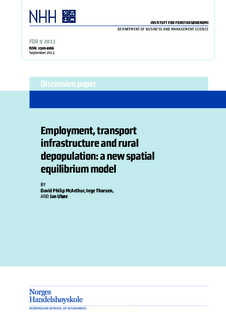| dc.contributor.author | McArthur, David Philip | |
| dc.contributor.author | Thorsen, Inge | |
| dc.contributor.author | Ubøe, Jan | |
| dc.date.accessioned | 2014-12-15T10:49:38Z | |
| dc.date.available | 2014-12-15T10:49:38Z | |
| dc.date.issued | 2013-09 | |
| dc.identifier.issn | 1500-4066 | |
| dc.identifier.uri | http://hdl.handle.net/11250/227235 | |
| dc.description.abstract | In this paper we propose a new spatial equilibrium model, and use it to discuss issues
related to rural depopulation. The discussion focuses on how investments in transport infras-
tructure and the spatial distribution of basic sector jobs can promote a relatively balanced
growth of peripheral and central areas of a region. Through interdependencies in individual
migration decisions and an economic base multiplier mechanism, negative exogenous shocks
may take a peripheral zone beyond a bifurcation point, into an equilibrium of dramatically
lower population and employment. We study how the location of bifurcation points depend
on spatial interaction behavioural parameters and variables subject to regional policy. We
also discuss the issue of the timing of interventions intended to prevent a process of rural
depopulation. | nb_NO |
| dc.language.iso | eng | nb_NO |
| dc.publisher | FOR | nb_NO |
| dc.relation.ispartofseries | Discussion paper;09/2013 | |
| dc.title | Employment, transport infrastructure and rural depopulation: a new spatial equilibrium model | nb_NO |
| dc.type | Working paper | nb_NO |
